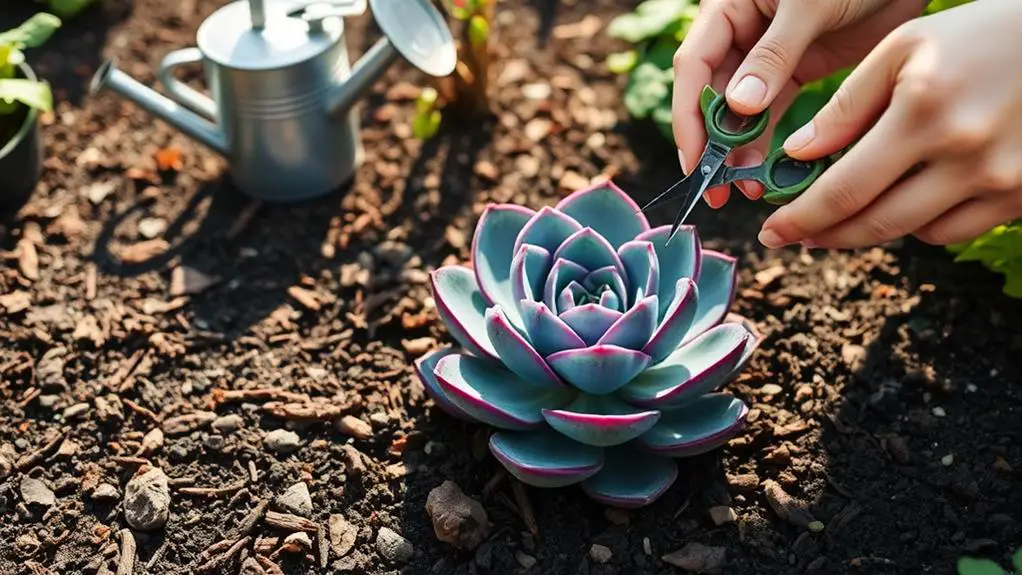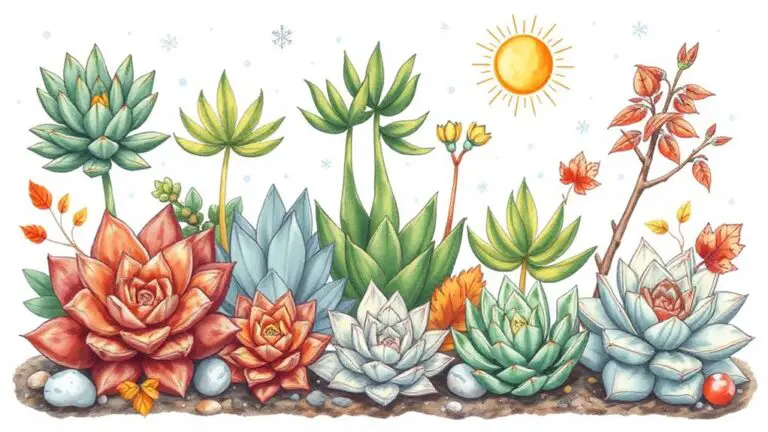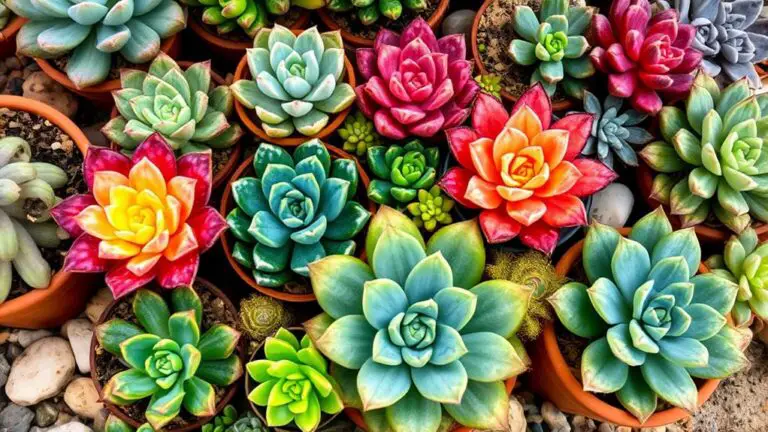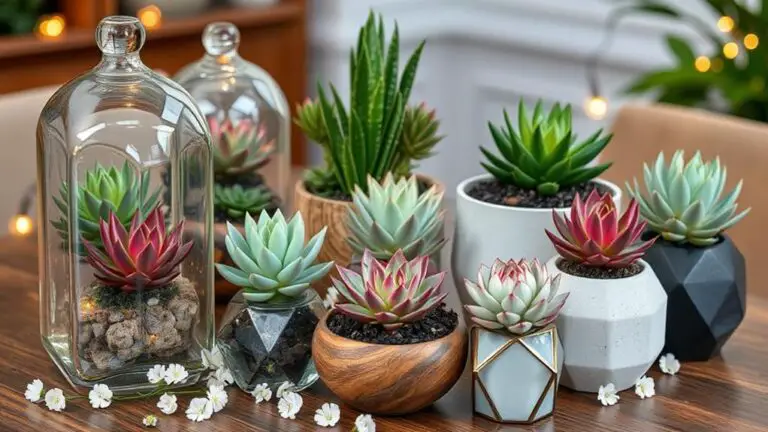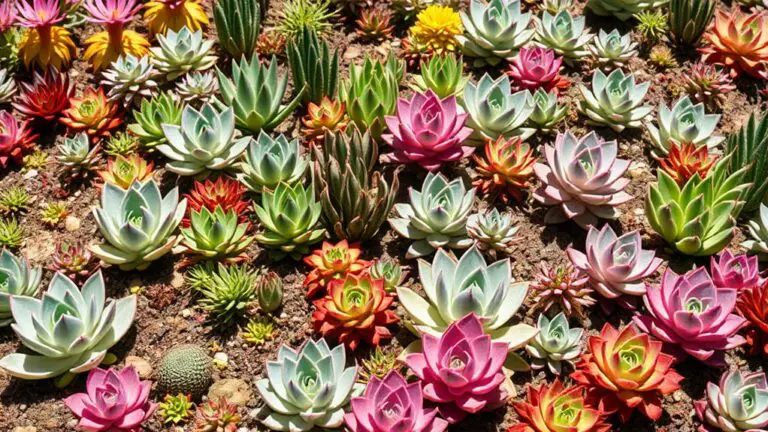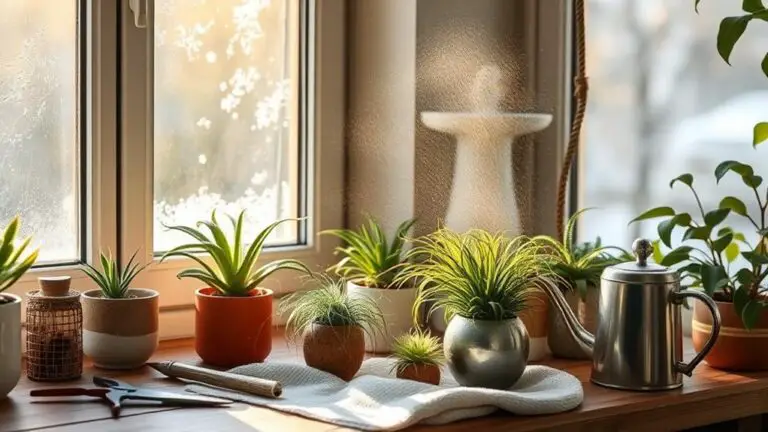10 Steps to Perfectly Care for Your Echeveria Black Prince
When caring for your Echeveria Black Prince, understanding its general needs is essential. You'll want to start with well-draining soil and a pot that has drainage holes to prevent root rot. Watering every 2-3 weeks, ensuring the top inch of soil dries out, keeps the plant healthy. Providing at least 6 hours of bright, indirect sunlight daily helps it thrive. But that's just the beginning—there are several more steps to perfecting your care routine. Want to make sure your Black Prince remains stunning and robust? Let's explore the details together.
Understand General Care

How do you guarantee your Echeveria Black Prince thrives? It all starts with understanding general care. This compact succulent, known for its unique dark coloration, needs the right conditions to grow healthy.
First, use well-draining soil specifically formulated for succulents and cacti. Regular garden soil retains too much moisture, which can lead to root rot.
Next, place your Echeveria Black Prince in a spot where it can receive at least six hours of bright, indirect sunlight daily. Direct sunlight might scorch its leaves, so indirect light is best.
Watering is another vital factor. Let the soil dry out completely between waterings. Overwatering can cause fungal diseases and root rot, so be careful.
In addition to proper watering and sunlight, pay attention to temperature. Echeveria Black Prince prefers mild to warm temperatures, ideally between 65°F to 75°F.
Regularly check your plant for pests like aphids and mealybugs. If you spot any, treat them promptly to keep your succulent healthy.
Provide Ideal Light
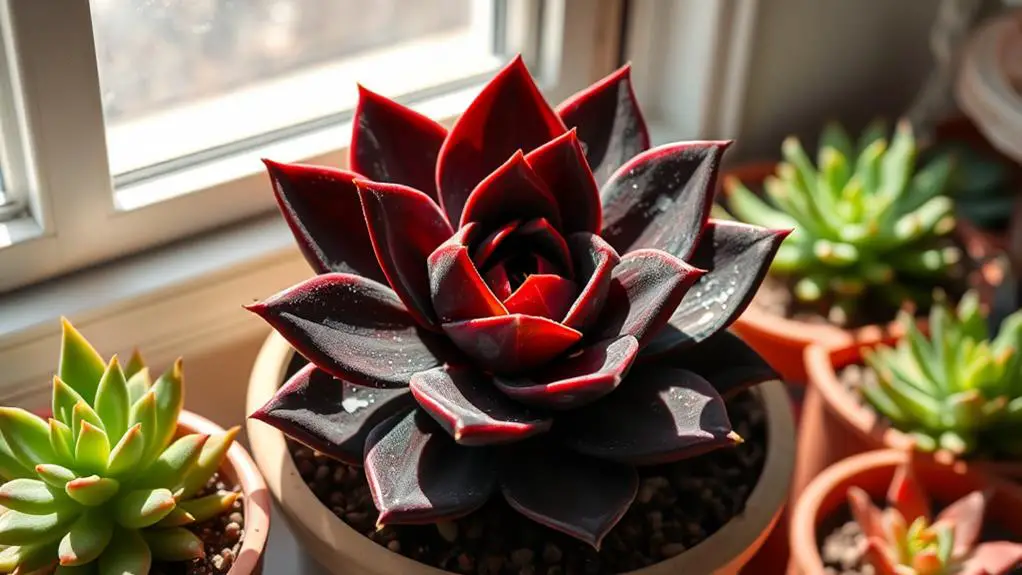
To help your Echeveria Black Prince thrive, make sure it gets bright, indirect sunlight for at least 6 hours daily.
Place it near a south-facing or west-facing window, but remember to protect it from harsh midday sun to prevent sunburn.
If natural light is limited, using LED grow lights can simulate the needed intensity and keep your plant healthy.
Optimal Sunlight Placement
Echeveria Black Prince thrives best with at least six hours of bright, indirect sunlight each day, ensuring it maintains its striking dark coloration.
To achieve ideal sunlight placement, position your plant near a south-facing or west-facing window. These spots will provide the bright indirect sunlight your Echeveria needs without exposing it to the harsh midday sun, which can cause leaf burn or sunburn damage.
If you're growing your Echeveria Black Prince outdoors, choose a location that offers partial sun or filtered sunlight. This setup protects the leaves from scorching while still giving them enough light to stay healthy.
You might use a shade cloth or place the plant under a tree or pergola for this purpose.
In cases where natural sunlight is limited, don't worry. You can use artificial grow lights to supplement the light your plant receives.
Position these lights at appropriate distances to mimic the intensity of sunlight. Make sure the grow lights provide a balanced light spectrum for the best results.
Balancing Light Exposure
Balancing light exposure is key to maintaining the health and beauty of your Echeveria Black Prince. This plant thrives in bright, indirect sunlight and needs at least 6 hours of light daily. Placing it near south-facing or west-facing windows gives it ideal light exposure. Too much direct light can cause sunburn, leading to brown or white patches on its leaves. So, be cautious and provide partial sun or filtered sunlight, especially if outdoors.
If your Black Prince gets insufficient light, it can become leggy and its foliage may fade. Regularly monitor and adjust its position if you notice these changes. Artificial grow lights can help when natural sunlight isn't enough, ensuring your plant receives the necessary intensity and duration of light.
Here's a quick reference table to help you balance light exposure:
| Light Condition | Indoor Placement | Outdoor Placement |
|---|---|---|
| Bright, indirect sunlight | South or west-facing windows | Partial sun or filtered light |
| Too much direct light | Move away from midday sun | Use shade cloth if needed |
| Insufficient light | Consider artificial grow lights | Reposition to a brighter spot |
Artificial Light Solutions
For those times when natural sunlight isn't enough, artificial light solutions become vital for keeping your Echeveria Black Prince healthy and vibrant.
Using artificial light, like LED grow lights, guarantees your plant gets the bright indirect light it needs. Aim for at least 6 hours of this light daily to promote ideal growth and beautiful coloration.
Position your grow lights about 12 inches away from the plant. This distance simulates natural sunlight intensity without causing leaf burn. To maintain consistent light exposure, use a timer. This helps mimic the natural day-night cycle, which is essential for your Echeveria Black Prince's healthy development.
Full-spectrum grow lights are a fantastic choice. They provide a balanced spectrum of light, which is beneficial for photosynthesis and overall plant health.
As your plant grows, regularly adjust the positioning of the lights. This guarantees all parts of the plant receive adequate light.
Maintain Correct Temperatures
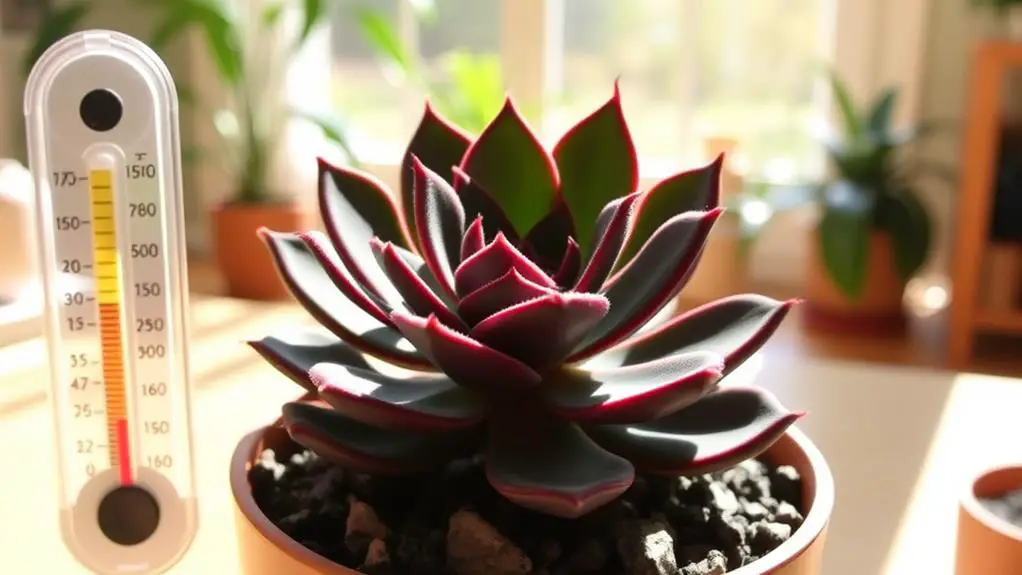
When caring for your Echeveria Black Prince, ensuring the correct temperatures is essential for its health and growth. This plant thrives in mild to warm temperatures, ideally between 65°F to 75°F (18°C to 24°C), which supports ideal growth. It's best suited for USDA hardiness zones 9 to 11. Remember, this succulent is not frost-tolerant, so you should protect it from freezing conditions to prevent temperature stress.
Sudden temperature fluctuations or exposure to extreme heat can harm your plant's health and coloration. During winter dormancy, make sure temperatures don't drop below 50°F (10°C) to avoid damage. Regularly monitoring indoor and outdoor temperatures will help you maintain a stable environment for your Echeveria Black Prince.
Here's a handy table to guide you:
| Temperature Range | Impact on Plant | Action Needed |
|---|---|---|
| 65°F to 75°F (18°C to 24°C) | Ideal growth | No action needed |
| Below 50°F (10°C) | Potential damage | Move indoors or protect |
| Above 75°F (24°C) | Risk of temperature stress | Increase humidity levels, provide shade |
Watering Guidelines
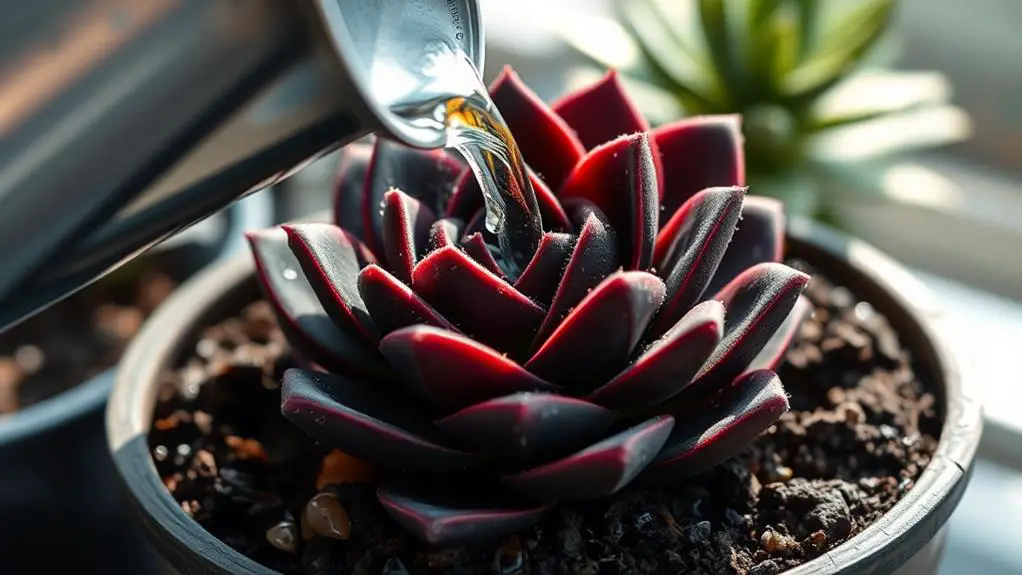
Maintaining the correct temperature for your Echeveria Black Prince is only one aspect of its care; proper watering is equally important. To keep your succulent healthy, you should water it every 2-3 weeks. Make certain the top inch of soil is completely dry before you water again. Overwatering can cause root rot, which is harmful to your plant.
When you water, use about 0.5 cups of water. Pour it directly around the base of the plant. Ascertain the water drains out of the pot's drainage holes. This helps prevent water from sitting in the soil and causing root rot.
Check the soil moisture regularly. If the leaves become mushy, you're probably overwatering. If they shrivel and lose color, the plant needs more water.
During the winter, reduce the watering frequency because the plant's growth slows down. This prevents excess moisture. Always use a well-draining soil mix formulated for succulents and cacti. This kind of soil promotes healthy root growth and prevents waterlogging.
Choose the Right Soil
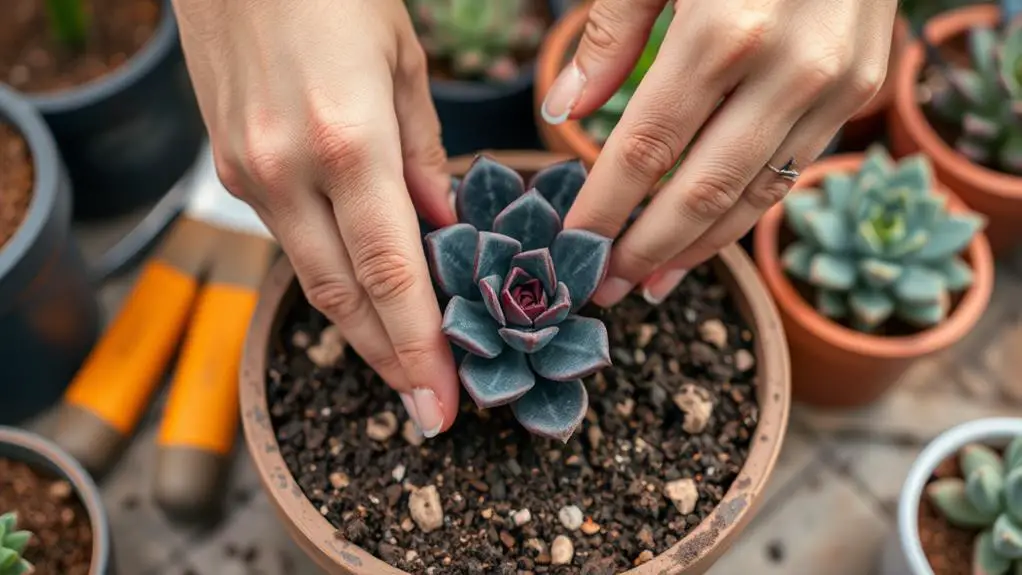
Choosing the right soil is essential for your Echeveria Black Prince to thrive.
Use a well-draining mix meant for succulents and cacti, combining 2 parts potting soil, 1 part perlite or pumice, and 1 part coarse sand.
Make sure your pot has drainage holes to let excess water escape and prevent root rot.
Optimal Soil Composition
Your Echeveria Black Prince's health heavily depends on the right soil composition. Ensuring you use well-draining soil is essential to prevent root rot caused by excess water. A cactus or succulent mix works best, as it includes sand, perlite, or pumice to enhance drainage and keep the roots healthy.
For ideal soil composition, follow this simple recipe:
- Two parts potting soil: This forms the base, providing essential nutrients.
- One part perlite or pumice: These materials improve drainage and aeration.
- One part coarse sand: This further enhances drainage, preventing water from sitting around the roots.
Avoid using regular garden soil, as it retains too much moisture and can introduce harmful pathogens.
Repotting your Echeveria Black Prince at least once a year or when the plant doubles in size helps refresh nutrients and maintain good soil health.
When repotting, always choose pots with drainage holes. These holes are key for letting excess water escape, promoting healthy root development.
Drainage Hole Necessity
While guaranteeing the right soil composition is important, the necessity of drainage holes in your pots can't be overstated. These holes are critical for preventing waterlogging, which can lead to root rot and other moisture-related problems. Your Echeveria Black Prince needs well-draining soil to thrive, and drainage holes guarantee any excess water escapes, keeping the roots healthy.
Choose a pot with adequate drainage holes to avoid water sitting at the bottom, which can suffocate the roots. Regularly check these holes to make certain they're not blocked. This simple step helps maintain peak plant health by allowing proper airflow and moisture control.
Using a well-draining soil mix is essential. Combine 2 parts potting soil, 1 part perlite or pumice, and 1 part coarse sand. This mix prevents water retention that could harm your Echeveria. Avoid standard garden soil, as it holds too much moisture and can harbor pathogens.
Selecting the right pot size is also important. A pot that's too large can retain too much moisture, compromising plant health. Aim for one that allows the roots to spread without excess water retention.
Soil Mix Ratios
For ideal growth, it's crucial to use the right soil mix for your Echeveria Black Prince. A well-draining soil mix is key to preventing root rot and guaranteeing your succulent thrives.
Here's a simple and effective soil mix recipe:
- 2 parts potting soil: This provides the necessary nutrients your succulent needs.
- 1 part perlite or pumice: These materials improve drainage and aeration, keeping the roots healthy.
- 1 part coarse sand: Sand prevents water retention and mimics the natural habitat of succulents.
Avoid using regular garden soil. It often contains pathogens and pests that can harm your Echeveria Black Prince.
Always verify the container you use has drainage holes. These holes prevent waterlogging, which can lead to root rot, especially if you're not careful with watering.
If mixing your own soil seems like too much work, consider using a commercial cactus or succulent soil mix. These mixes are specifically designed to meet the needs of succulents, making it easier for you to care for your plant.
Remember to check the soil regularly. If it becomes compacted or depleted of nutrients, replace it at least once a year.
This practice helps maintain the best conditions for your Echeveria Black Prince's growth. Happy planting!
Fertilization Tips

When it comes to fertilizing your Echeveria Black Prince, less is often more. These succulents thrive in nutrient-poor environments, meaning they don't need frequent fertilization.
During the growing season—spring and summer—you should use a diluted, balanced fertilizer at half or quarter strength. This helps avoid root damage while still providing essential nutrients.
Opt for a fertilizer with lower nitrogen content. Too much nitrogen can disrupt your plant's deep, beautiful coloration and even stunt its growth.
Regular monitoring for signs of nutrient depletion is vital. If you notice stunted growth or yellowing leaves, it might be time for repotting or a slight nutrient boost.
It's also important to remember that if you replace your Echeveria Black Prince's soil annually, regular fertilization becomes unnecessary. Fresh soil usually contains all the nutrients your plant needs for healthy growth.
Always follow detailed fertilization guidelines to guarantee you're not over-fertilizing. Overdoing it can lead to more harm than good, so stick to these tips for ideal nutrient management.
Monitor for Common Problems

Guaranteeing your Echeveria Black Prince gets the right nutrients is only part of keeping it healthy. Regularly monitoring for common problems is essential to make certain your plant thrives. Here's what you should look out for:
1. Monitor for yellowing leaves: Yellow or brown leaves can signal overwatering or insufficient light. Adjust your watering schedule and guarantee the plant gets at least 6 hours of bright, indirect sunlight daily.
If you notice leggy growth, it's a sign of inadequate sunlight, so move your plant to a sunnier spot.
2. Check for signs of root rot: Root rot is a serious issue, often caused by waterlogged conditions. Look for mushy leaves or a foul odor from the soil.
Make sure you're using well-draining soil to prevent this. If you suspect root rot, let the soil dry out completely before watering again.
3. Inspect for pests such as aphids: Pests like aphids, mealybugs, and spider mites can weaken your Echeveria Black Prince.
Regularly check the leaves for these pests and remove them promptly to keep your plant healthy.
Handle Pests and Diseases
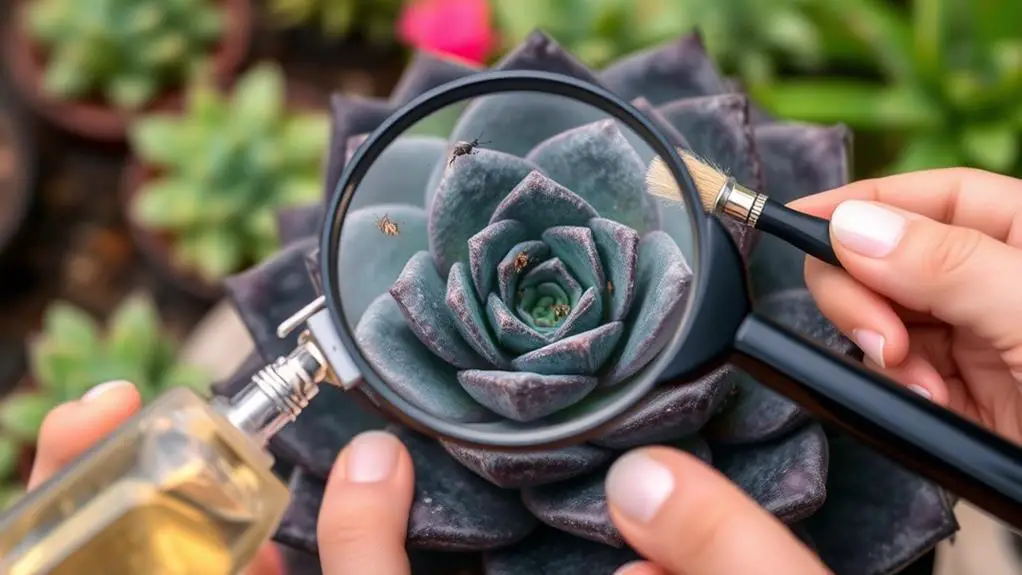
To keep your Echeveria Black Prince healthy, you'll need to watch out for pests like aphids, mealybugs, and spider mites.
If you spot any, treat your plant with insecticidal soap or a mix of water and dish soap, making sure to cover both sides of the leaves.
Good air circulation can help prevent fungal diseases, so don't forget to give your plant some space to breathe.
Identifying Common Pests
How can you tell if your Echeveria Black Prince is under attack by pests? Keep an eye out for common culprits like aphids, mealybugs, and spider mites, which can harm your plant's health. Regularly inspect the undersides of leaves and the base of the plant for signs of pest infestations. Look for sticky residue or webbing—these are telltale signs of spider mites.
Here are three specific indicators to watch for:
- Sticky Residue: If you notice a sticky substance on the leaves, it might be from mealybugs or aphids. This residue can also attract mold.
- Webbing: Tiny webs, especially on the undersides of leaves, suggest spider mites. These pests can cause significant damage if not addressed.
- Yellowing or Shriveled Leaves: Changes in your plant's appearance, like yellowing or shriveled leaves, can indicate stress from pest infestations.
To maintain your plant's health, treat any infestations promptly with insecticidal soap or neem oil. Confirm you cover affected areas thoroughly.
Also, remember that high humidity and poor air circulation can worsen pest problems. Good airflow around your plant can help prevent infestations and keep your Echeveria Black Prince thriving.
Effective Treatment Methods
Dealing with pests and diseases in your Echeveria Black Prince can be straightforward with the right approach. First, regularly inspect your plant for common pests like aphids, mealybugs, and spider mites. If you spot any, treat them promptly with insecticidal soap or neem oil.
To prevent fungal diseases, maintain a well-ventilated growing environment. Fungal diseases thrive in damp conditions, so good air circulation is key.
| Issue | Sign | Solution |
|---|---|---|
| Root Rot | Yellowing, mushy leaves | Use well-draining soil, pots with drainage holes |
| Fungal Diseases | Mold or spots on leaves | Improve air circulation, let soil dry between waterings |
| Sunburn | Brown, crispy leaves | Move to a spot with filtered sunlight |
If you notice yellowing or mushy leaves, it may indicate root rot. Confirm you're using well-draining soil and pots with drainage holes to prevent waterlogging. For sunburned leaves, relocate your Echeveria Black Prince to a spot with filtered sunlight to avoid harsh midday rays that can cause damage.
To handle high humidity that may lead to fungal infections, allow the soil to dry out more thoroughly between waterings. You can also use a fan to improve air circulation around the plant. By following these steps, your Echeveria Black Prince will stay healthy and beautiful.
Potting and Repotting
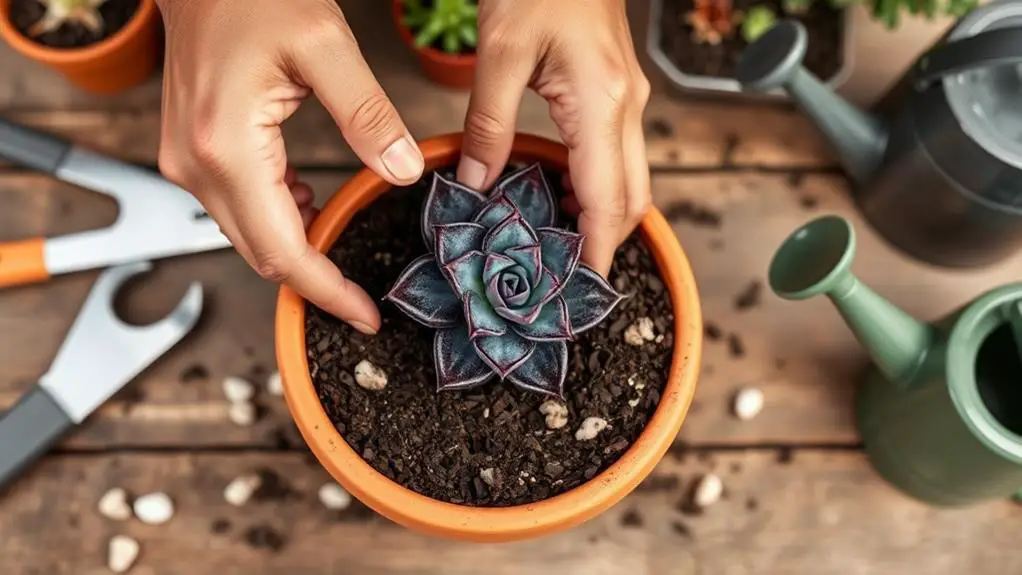
When potting and repotting Echeveria Black Prince, selecting the right container is essential. You'll want to choose a pot with drainage holes to prevent waterlogging, which can lead to nasty root rot.
Equally important is using well-draining soil. A good mix for this is 2 parts potting soil, 1 part perlite, and 1 part coarse sand. This combination guarantees your plant's roots stay healthy and dry.
When you're ready to repot, do it when the plant doubles in size or at least once a year. This practice refreshes the soil and gives your Echeveria more room to grow, preventing nutrient depletion.
Here's a quick checklist to make the process easier:
- Pick a pot: Make sure it has drainage holes to avoid water buildup.
- Prepare the soil: Use a well-draining mix tailored for succulents and cacti.
- Position the plant: Keep it at the same soil level as in its old pot to avoid stem rot.
After repotting, let the soil dry out completely before watering. This step reduces the risk of overwatering stress on your newly potted plant.
Following these steps will keep your Echeveria Black Prince thriving.
Propagation Methods
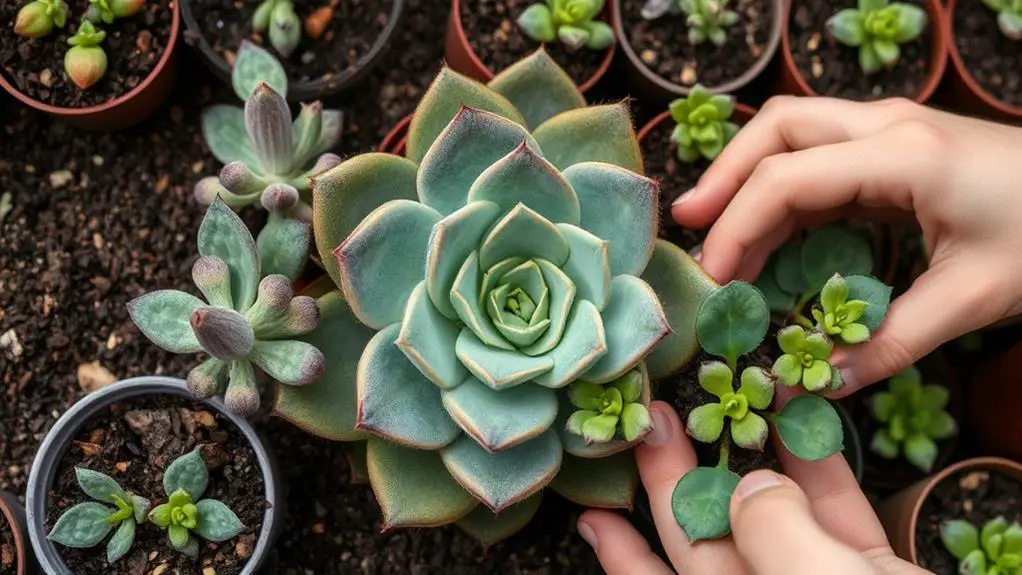
After ensuring your Echeveria Black Prince is comfortably potted, you might want to expand your collection. Propagation methods for this striking succulent are straightforward.
One popular way is through leaf cuttings. Gently twist off a healthy leaf from the main plant. Let it dry and callous for a few days to prevent rot. Once dried, place the leaf cuttings on well-draining soil. Keep the soil slightly moist, but avoid overwatering to prevent rot.
Another easy method is using offsets, or "pups," that grow around the base of the mother plant. Gently remove these offsets and replant them in well-draining soil. They tend to root quickly and are a reliable way to grow new plants.
Spring and early summer are the best times for propagation, as your Echeveria Black Prince will be actively growing.
Maintain a warm and humid environment to encourage root development. This can be done by placing a clear plastic cover over the new plants, creating a mini-greenhouse effect.
Frequently Asked Questions
How Do You Care for Echeveria Black Prince?
To care for your Echeveria Black Prince, place it in bright, indirect sunlight for 6 hours, water every 2-3 weeks, use well-draining soil, maintain 65-75°F, and fertilize sparingly with diluted, low-nitrogen fertilizer during growth.
How Do I Take Care of My Echeveria?
Place your Echeveria near a sunny window, water it every 2-3 weeks after the soil dries out, use well-draining soil, fertilize sparingly in spring and summer, and watch for pests like mealybugs and spider mites.
What Does an Overwatered Echeveria Look Like?
An overwatered Echeveria shows yellowing, mushy leaves and brown or black spots, often starting at the base. The plant may look droopy, with shriveled leaves that drop off. Make certain the soil dries out completely between waterings.
Is Black Prince a Juicy Plant?
Yes, the Black Prince is indeed a juicy plant. Its fleshy, thick leaves store water, making it drought-resistant. You'll notice its plump, vibrant leaves, which are a hallmark of its ability to retain moisture efficiently.
Conclusion
Caring for your Echeveria Black Prince can be a rewarding and enjoyable experience. Just follow these steps: provide the right light and temperature, water wisely, choose well-draining soil, and keep an eye out for pests. Don't forget to repot when needed and try propagation in spring. With a little attention and care, your plant will thrive. You've got this—happy gardening!

